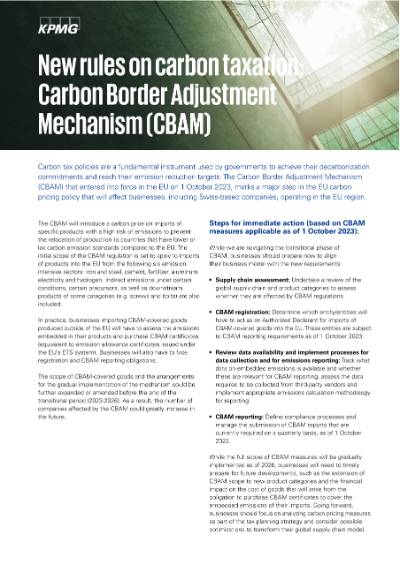Steuern sind sicherlich nicht der naheliegendste Nachhaltigkeitsfaktor. Doch nicht nur in der Schweiz, sondern weltweit erzeugt die Politik mittels Steuern Push- und Pull-Effekte, um auf die Geschäftspraxis und auf Verhaltensweisen einzuwirken: Einerseits gewährt sie Steueranreize, Investitionserleichterungen und Finanzmittel für nachhaltige Unternehmen, andererseits erhebt sie Steuern auf umweltschädliche Aktivitäten wie Energie- und Ressourcenverbrauch, Transport und Verschmutzung.
Auch bei vielen Zielen für nachhaltige Entwicklung der Vereinten Nationen (Sustainable Development Goals, SDG) spielen Steuern eine wichtige Rolle, denn Steuereinnahmen können den Wohlstand von Gesellschaften nachhaltig beeinflussen. Wie viele Steuern ein Unternehmen bezahlt, wo es sie bezahlt und wie es sich in Steuerfragen verhält, wird immer öfter als ESG- oder Nachhaltigkeitskriterium gewertet. Schliesslich sind die Steuereinnahmen, die Regierungen und Gesellschaften zur Verfügung stehen, eine Voraussetzung dafür, dass diese Debatte überhaupt geführt werden kann.
Unternehmen müssen potenzielle, mit Umweltsteuern verbundene Risiken und Chancen einschätzen und ihre Strategie unter dem Gesichtspunkt der Steuertransparenz beurteilen. Die Experten von KPMG können Sie auf diesem Weg mit Erkenntnissen über Best Practice und mit technologischen Lösungen begleiten und sicherstellen, dass steuerliche Aspekte in Ihrer ESG-Strategie angemessen berücksichtigt werden.
Welcher Zusammenhang besteht zwischen Steuern und ESG?
Steuern wirken sich auf alle drei Bereiche aus:
Im Umweltbereich (E) geht es um die Erhebung von Umweltsteuern, darunter eine CO2-Steuer, mit denen Unternehmen auf der Grundlage ihrer Treibhausgasemissionen belastet werden. Damit sollen Unternehmen ermutigt werden, ihren CO2-Fussabdruck zu verringern und zu umweltfreundlicheren und nachhaltigeren Verfahren überzugehen.
Die soziale Dimension (S), die sich auf den steuerlichen Fussabdruck von Unternehmen konzentriert, verlangt Transparenz in der Steuerberichterstattung und ein stärkeres soziales Bewusstsein für Steuern.
Governance-Aspekte (G) beziehen sich auf nachhaltige Steuerkontrollrahmen und eine angemessene Berücksichtigung von Steuerangelegenheiten auf Verwaltungsratsebene.
Video auf Englisch
Das «E» – Umweltsteuern
Umweltsteuern – oder «grüne» Steuern – werden als flexibles ökonomisches Instrument zur Erhöhung der Steuereinnahmen und zur Durchsetzung des Verursacherprinzips eingesetzt.
Die Regierungen der Schweiz und zahlreicher anderer Länder weltweit haben erhebliche Fortschritte bei der Einführung einer Klimapolitik erzielt, die Umweltsteuern – insbesondere rund um den Mechanismus zum CO₂-Grenzausgleich (Carbon Border Adjustment Mechanism, CBAM) der EU – mit Nachhaltigkeitsregelungen für Produkte wie Kunststoffe und Verpackungen verbindet.
Überdies erhöhen viele Regierungen steuerliche Anreize und andere Zuschüsse und Zulagen, um Verhaltensweisen zu reduzieren, welche die Umwelt belasten und zum Klimawandel beitragen.
Für Unternehmen geht es nicht mehr nur darum, Anforderungen einzuhalten, sondern sich die verfügbaren Anreize und Zulagen zunutze zu machen.

Dekarbonisierung
Einführung neuer CO₂-Abgaben und weiterer Massnahmen zur Kontrolle der Verlagerung von CO₂-Emissionen, wie zum Beispiel der Mechanismus zum CO₂-Grenzausgleich (Carbon Border Adjustment Mechanism, CBAM) der EU, die Revision der Verbrauchssteuersätze, die schrittweise Aufhebung von Steuerbefreiungen für bestimmte stark verschmutzende Sektoren sowie die Reform der Emissionshandelssysteme (EHS).

Kreislaufwirtschaft
Förderung des Übergangs zu einem zirkulären System für Produkte und zu Reduktion, Wiederverwendung und Rezyklierung (R3: Reduce, Reuse, Recycle) durch Regelwerke, einschliesslich Steuern auf Energie, Ressourcen, Kunststoffe und Verpackungen.

Nachhaltige Entwicklung
Förderung der Finanzierung von grünen Investitionen für bestimmte Branchen, sowie Schaffung von Steueranreizen oder Steuergutschriften für Unternehmen mit dem Ziel, sie zu einer nachhaltigeren Geschäftspraxis zu veranlassen.
Das «S» und das «G» – Gute Unternehmensführung und Steuertransparenz
Aufgrund von Nachhaltigkeitsentwicklungen, die zeitlich mit BEPS 2.0 zusammenfallen, gewinnen Steuerkontrollsysteme und Steuerprozesse zunehmend an Bedeutung. Ein klar definiertes Steuer-Governance-Framework ist der Schlüssel zum Erfolg der ESG-Politik und Nachhaltigkeitsstrategie von Unternehmen.
Doch von Unternehmen wird nicht nur erwartet, dass sie über ein solides Steuer-Governance-Framework verfügen und im Einklang mit den Gesetzen Steuern zahlen, sondern auch, dass sie ihr Vorgehen transparent darstellen. Im vergangenen Jahrzehnt wurden zahlreiche Initiativen und Standards in die Wege geleitet und sind entweder bereits in Kraft getreten oder werden in naher Zukunft wirksam. Folglich nimmt die Komplexität rund um das Thema Steuertransparenz immer mehr zu und die Debatte gewinnt deutlich an Dynamik.
Die Debatte über Steuertransparenz wird vor allem von regulatorischen Vorstössen und Marktkräften angetrieben.
- Regulatorische Vorstösse: Internationale und/oder nationale Regelwerke mit dem Ziel, durch Transparenz Vertrauen zu bilden, sind entweder bereits in Kraft getreten oder gewinnen an Unterstützung. Einige der Vorschriften und Standards sind rechtlich bindend (wie CbCR, CRD-IV, die EU-Bilanzrichtlinie oder nationale Bestimmungen in Grossbritannien, Australien, Norwegen usw.), während andere Regelwerke wie die UN-PRI oder die GRI-Standards freiwilliger Natur sind. Weitere sollen in naher Zukunft umgesetzt werden, wie die EU-Richtlinie zur öffentlichen länderbezogenen Berichterstattung (Public Country-by-Country-Reporting, CbCR).
- Marktkräfte: Sobald Unternehmen Nachhaltigkeitsziele und -strategien festgelegt haben, wächst der Druck auf sie, ihre Steuertransparenz entsprechend anzupassen und sie mit ihrer Kommunikationsstrategie und den Positionen ihrer Wettbewerber in Einklang zu bringen. Hinzu kommt, dass sich auch Anleger verantwortungsbewusster verhalten wollen. Steuertransparenz wird daher verstärkt als relevante Kennzahl in Nachhaltigkeitsrankings angesehen.
Welche Rolle spielen Steuerexperten bei der Umsetzung von ESG-Aspekten?
Steuerexperten spielen eine wichtige Rolle bei der Umsetzung von ESG-Aspekten. Unter anderem können sie folgende Aufgaben übernehmen:
- Sicherstellen, dass die verfügbaren Steuererleichterungen («Zuckerbrot») in vollem Masse in Anspruch genommen werden, um die Finanzierung des Übergangs zu sichern und Mehrwert zu schaffen
- Sicherstellen, dass die Kosten von Umweltsteuern für das bestehende Geschäftsmodell verstanden werden
- Die steuerlichen Aspekte analysieren, die mit dem Wechsel des Geschäftsmodells sowie mit aktualisierten und optimierten Liefer- und Wertschöpfungsketten verbunden sind
- Dafür sorgen, dass das Unternehmen mit den sich verändernden Umweltsteuersystemen Schritt hält und diese einhält, einschliesslich der Entwicklung effektiver Zielgeschäftsmodelle und einer wirksamen Governance
- Beurteilen, ob das Steuer-Governance-Framework und die Steuerprozesse die Erwartungen der verschiedenen Stakeholder erfüllen – auch wenn sie öffentlich unter die Lupe genommen werden
- Wissen, welche rechtlich verbindlichen oder optionalen Standards anzuwenden sind (BEPS-Säule 2, Public CbCR, GRI-Rahmen usw.)
- Beurteilen, ob die erforderlichen Daten, d. h. jene, die das Unternehmen offenlegen will oder muss, aus den aktuellen Systemen extrahiert werden können
- Eine Risikobeurteilung durchführen, um festzustellen, welche Massnahmen getroffen werden müssen, und den Kontext ermitteln, in denen diese Daten dargestellt werden sollten, um potenzielle Reputationsrisiken zu steuern Berücksichtigen, ob eine unabhängige Prüfung/Assurance aller oder einiger der Daten durchgeführt werden sollte, die offengelegt werden sollen
Unsere Expertise in steuerlichen Aspekten von ESG
Mit unserer umfassenden Expertise unterstützen wir Ihr Unternehmen dabei, neue Steuerregelungen einzuhalten, steuerliche Aspekte in Ihre ESG-Strategie zu integrieren und Ihre ESG-Ziele zu ergänzen:
- ESG-Steuerstrategie: Wir bieten steuerspezifische ESG-Workshops an, um wesentliche Steuerfragen gemeinsam effektiv zu beantworten, und gelangen so rascher zu einer steuerlichen ESG-Strategie und deren Mehrwert.
- Steuer-Governance: Wir erarbeiten Steuer-Governance-Frameworks und bereiten Steuertransparenz vor oder erstellen Berichte über den Gesamtsteuerbeitrag, um Steuer- und Reputationsrisiken zu bewirtschaften.
- Nachhaltige Lieferkette: Wir ermitteln, wie Steuerbelange in Lieferkettenstrategien integriert werden können, und beurteilen potenzielle Risiken und Chancen in Zusammenhang mit steuerlichen Aspekten.
- Anreize, Zulagen und Steuererleichterungen: Wir identifizieren und beantragen weltweit verfügbare Steuererleichterungen, -zulagen oder -anreize, um ESG-Initiativen zu finanzieren und Mittel freizusetzen.
- Umweltsteuern: Wir beraten Sie im Hinblick auf die finanziellen Auswirkungen von Umweltsteuern, einschliesslich Compliance und Berichterstattung, Folgenabschätzung, Rückforderung von Überzahlungen und Schlichtung von Streitigkeiten.
- Emissionshandel: Wir helfen Ihnen, Steuern und die umfassenderen Auswirkungen der Einrichtung einer Emissionshandelsfunktion zu verstehen und zu bewirtschaften.
- Roadmap zur Steuertransparenz: Wir bieten eine Aussenperspektive darauf, wo ein Unternehmen in puncto Steuertransparenz steht, sowie Erkenntnisse, die auf unseren Erfahrungen mit Kunden, Branchenvertretern und Investoren beruhen. Zudem arbeiten wir Roadmaps für den Weg zur Steuertransparenz.
- Berichterstattung über steuerliche Auswirkungen: Wir unterstützen Ihre Steuerabteilung bei der Information Ihrer Stakeholder über Ihren Ansatz in puncto Besteuerung und helfen Ihnen, mit datengestützten Methoden Informationen über Ihren Steuerfussabdruck zu erfassen
- EU Public CbCR: Wir analysieren Ihr aktuelles CbCR-Profil und die damit verbundenen Risiken, bieten Orientierungshilfen und schlagen Massnahmen zur Vorbereitung des CbCR-Berichts vor.
Ihre Vorteile
Unser Team von ESG-Steuerexperten unterstützt Sie bei der strategischen und wertorientierten Steuerplanung, um nachhaltige Geschäftsmodelle und Wertschöpfungsketten im Einklang mit Ihrer langfristigen ESG-Politik voranzutreiben.
Wir sorgen dafür, dass Sie mit Umweltsteuern sowie mit den Regelwerken und Vorstössen zur Berichterstattung über Steuertransparenz Schritt halten und gleichzeitig Chancen und Steueranreize nutzen können, die durch ESG-Trends im steuerlichen Bereich entstehen.
Kontaktieren Sie unsere ESG-Expertinnen und Experten
Unsere Experten helfen Ihnen nicht nur, Umweltsteuerbestimmungen, CO₂-Bepreisungsprogramme und Steuertransparenzstandards in der Schweiz und weltweit einzuhalten, sondern stellen auch sicher, dass Steuern als Teil einer ganzheitlichen, langfristigen ESG-Strategie auf multidisziplinäre Weise berücksichtigt werden.






